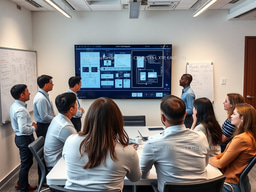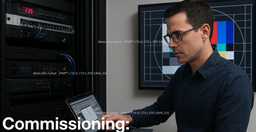The Strategic Role of Scoreboards & Ribbon Displays in Modern AV Infrastructure

When people hear the term "stadium technology," their first thoughts often go to the massive screen displaying the score or perhaps some high-resolution slow motion replay. While these are certainly visible outputs, they represent just the surface layer of a far more sophisticated AV ecosystem. In reality, scoreboards and ribbon displays are integral components of a venue’s live-event technology infrastructure, with applications that go well beyond the scoreboard's traditional role.
These systems are not simply display elements; they are complex, interconnected platforms that combine real time data, dynamic media, audio integration, centralized control and monetization strategies into a unified AV solution. Let’s break down the full scope of what these systems deliver in the context of today's venues and large scale events.
1. Real-Time Scoring and Data Integration
At the core, scoreboards are data-driven. They ingest live feeds from official scoring systems, statistics databases and player tracking platforms. Integration with league APIs and venue-specific systems allows for:
-
Instantaneous display of scores, fouls, penalties and player stats.
-
Synchronization across multiple displays and digital signage networks.
-
Elimination of latency between event occurrence and audience visibility.
This real-time accuracy is essential not just for fan experience, but for regulatory compliance in certain leagues and broadcast standards.
2. Advanced Video Distribution and Playback
Modern scoreboards operate as high-bandwidth video delivery platforms, managing inputs from:
-
Live production switchers and broadcast trucks.
-
On-site and remote controlled PTZ cameras.
-
Media servers hosting pre-produced video segments, animations or sponsor reels.
With pixel pitches now capable of supporting 4K and even 8K resolutions and refresh rates supporting high frame rate sports content, these systems serve dual roles as both production display surfaces and fan engagement tools.
3. Ribbon Boards: The Peripheral Powerhouse
Ribbon displays—often mounted along arena balconies or fascia—extend the scoreboard’s utility by wrapping audiences in 360° content experiences. Technically speaking, they:
-
Operate on independent display controllers with synchronized timelines.
-
Support dynamic content rotation including motion graphics, fan prompts, player intros and emergency notifications.
-
Offer programmable ad inventory with dayparting, geo-targeting and campaign scheduling via CMS platforms.
They are crucial for maintaining venue-wide consistency in both branding and information flow.
4. Audio-Visual Synchronization for Immersive Impact
One of the key differentiators in high-performance AV environments is audio-visual synchronization. Modern control systems ensure that:
-
Visual cues align with in-venue sound effects (buzzers, goal horns, music stings).
-
Event transitions are coordinated with lighting systems and video playback.
-
Crowd-engagement moments are amplified through coordinated AV triggers (e.g., “Make Some Noise” cues with visual pulses and bass hits).
This synchronization is not merely aesthetic—it significantly enhances emotional resonance and fan memory.
5. Centralized Command and Control Infrastructure
At the operational level, all display systems are orchestrated through a central AV control room, typically featuring:
-
Multiview production monitors for live camera feeds and playback status.
-
Real-time network diagnostics and fault-tolerant playback systems.
-
Redundant control systems to ensure failover in high-stakes environments.
Control room operators coordinate with broadcast teams, in-venue hosts and technical crews to dynamically switch content, troubleshoot errors and respond to live-event needs in real time.
6. Multi-Platform Content Integration and Connected Fan Experience
As part of broader digital transformation efforts in venues, scoreboard and ribbon display systems are increasingly integrated with:
-
Mobile apps (e.g., showing real-time stats, syncing with on-screen graphics).
-
IPTV systems throughout the venue (luxury suites, concessions, lounges).
-
Augmented reality overlays and second-screen experiences.
This multi-platform synchronization ensures that whether a fan is in their seat, at the concession stand or watching from home, their experience remains seamless and informed.
7. Revenue Optimization via Digital Advertising
From a commercial perspective, ribbon boards and scoreboards have become digital real estate assets. AV teams collaborate with marketing and sales departments to:
-
Schedule rotating sponsor messages, branded animations and ad loops.
-
Use dynamic ad insertion (DAI) technology to target different zones or times.
-
Provide real-time metrics to advertisers on display duration and impression estimates.
The result is an AV asset that actively contributes to revenue streams, beyond its informational or entertainment value.
8. Custom System Architecture and Display Engineering
Each venue presents unique challenges related to viewing angles, lighting conditions, mounting restrictions and aesthetic considerations. AV integrators and engineers must:
-
Design bespoke LED enclosures and mounting solutions.
-
Specify displays based on brightness (nits), pitch, contrast ratio and viewing distance.
-
Conduct simulations to optimize sightlines and ensure ADA and safety compliance.
This makes each scoreboard/ribbon system a custom-engineered solution, not an off the shelf product.
9. Multi-Use Versatility for Different Event Formats
High-end display systems are built for flexibility across multiple event types, with content presets and playback profiles for:
-
Sports (scoreboards, player stats, replay automation).
-
Concerts (stage graphics, visualizers, crowd interaction).
-
Esports (real-time data overlays, team branding, sponsor activations).
-
Corporate or ceremonial events (presentations, live feeds, visual cues).
This multi-use capability increases return on investment (ROI) by maximizing event revenue with a single AV infrastructure.
10. Interdisciplinary Collaboration and Operational Precision
Bringing such systems to life requires coordinated efforts across:
-
AV system designers and integrators.
-
Software engineers and CMS specialists.
-
Content creators, motion graphic designers and media technicians.
-
On-site AV operators and technical directors.
Every moment on screen represents the output of a real-time collaboration between disciplines, supported by robust planning, simulation and testing protocols.
Finally, today’s scoreboards and ribbon displays are not peripheral systems, they are mission critical AV platforms driving real-time information delivery, brand engagement and immersive fan experiences. Whether it’s enabling a sold-out stadium to feel the energy of a last-minute goal or allowing advertisers to connect with fans through dynamic, targeted messaging, these systems sit at the core of next-generation venue technology.
Professionals in the AV industry must approach them not as simple hardware, but as integrated ecosystems requiring precision engineering, creative vision and flawless execution.
As AV technology continues to evolve, which emerging trends do you think will reshape scoreboard and ribbon display systems in the next 3–5 years?
-
Xchange Advocates are recognized AV/IT industry thought leaders and influencers. We invite you to connect with them and follow their activity across the community as they offer valuable insights and expertise while advocating for and building awareness of the AV industry.
Recommended Content
LetsTalkAVbyAlexis Series: Episode 4 : Design Begins With People: Engineering AV Systems Around Real End-User Requirements

LetsTalkAVbyAlexis Series : Episode 2: Network & AV Convergence (AVoIP)







Please sign in or register for FREE
If you are a registered user on AVIXA Xchange, please sign in